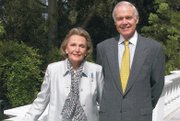Judy's Founder Pens Memoir, Encouraging Others to Follow Their Passion
For legions of fashion-conscious women over the past half-century, the Judy’s store was a key venue for building their wardrobes. Founder and designer Marcia Israel-Curley, now in her 70s, has detailed the ups and downs of this enterprise in her book “Defying the Odds: Sharing the Lessons I Learned as a Pioneer Entrepreneur.”
Israel-Curley got a taste of the garment industry with stints as a showrom model and bookkeeper and as a buyer for Mayson’s before venturing out on her own.
In 1948, barely 21 years old, Israel-Curley—with $1,000 she and her late husband, Larry Israel, pooled together—opened an 840- square-foot store on Whittier Boulevard in East Los Angeles to fill a retail void in the young women’s market. It was the first of what would become a powerful franchise. The store’s name was born out of necessity—the signage allowed only for five characters.
In 1989, when Israel was battling prostrate cancer, Israel-Curley decided to sell the then-104 stores.
Recently, Nola Sarkisian-Miller of the California Apparel News interviewed Israel-Curley (who remarried in 1995, to actor Jim Curley) in their Bel-Air home.
Are you seeing more women launch out on their own in the classes you teach at the University of Southern California’s (USC’s) Marshall School of Business?
I’ve been teaching at USC for 19 years, and in the first year there was not one woman. I now have two classeshellip;and each is composed of about 20 to 25 percent women. The numbers have come up quite a lot, but they’re still lagging. I think it’s a fear of hostile territory. It’s a man’s world. Even now.
How were you able to make the transition from employee to entrepreneur when you began Judy’s?
I didn’t even know I was transitioning. I wasn’t aware of the differences of having a responsible job or doing it myself. I didn’t pay attention to that, nor did I pay attention to the gender differences, because I found that as soon as the men I was dealing with recognized I knew what I was talking about, the gender differences disappeared.
What kind of living did you and your husband have in the beginning?
We made a minor living. The first 16 years were not easy—they were struggling years, but I just hung in there, because we were in love. I also fell in love with Judy’s—totally in love with Judy’s. I lived and breathed Judy’s. I slept at night for six hours, and I must have been dreaming of Judy’s because I woke up with new ideas every morning.
You had the best of both worlds—designing and running a business. What’s the message to fashion students today who may not have a business background?
You have to analyze design, and base it on who you’re designing for. There are designers who do outrageous, or they do sexy, and they’re good at it. So, students should know their customer and have the product that will please them, and then they have to be consistent. Every store has its image. Robinsons-May has an image, Bloomingdale’s has an image, and Macy’s has an image. If they stray from what is expected of them, they are making a mistake.
Markdowns are an industry nightmare. Why are there so many misses?
Those are buyers’ mistakes. It’s ridiculous for a store to limit a buyer to certain manufacturers. You don’t need to be a fashion expert to be a good buyer. I keep thinking I’d like to start a school for merchandising and buying in Los Angeles. Both of those arts can be successfully taught.
Through your friendship with Joseph Schenck [co-founder of 20th Century-Fox Studios], you had an opportunity to be an actress as a young girl. Why did you turn that down?
I never figured I was an actresshellip;I wasn’t comfortable with it. I tell my students, “Don’t follow a dream; follow what you like to do best, and make that your passion.”






















